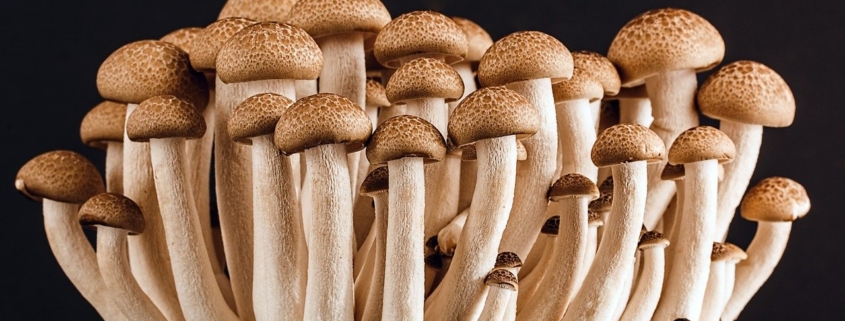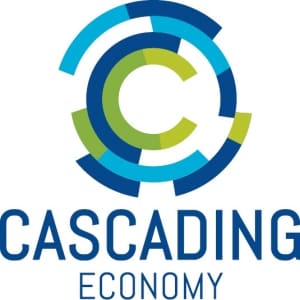
Tasty multi-talent: Fungi
Background: Fungi as the glue of our earth
Fungi are rather inconspicuous organisms at first glance. What we see are mostly brown or white fruiting bodies growing on forest edges and under trees. But their size is deceptive. The true size of fungi stretches under the ground, a complex network of root-like mycelium (= thread-like cells of fungi). Thus, a fungus is the largest organism on earth: a Hallimasch (honey mushroom) with 370,000 square meters and 440 tons of weight and a proud age of 2,500 years.1 The oldest finding of fungi was in rock formations in Congo and is 715 to 810 million years old.2 By the way, fungi are not plants, but form their own kingdom of living beings, which is the second largest after the animal kingdom. Because fungi are heterotrophic (feeding on others) and at the same time immobile, they have occupied specific niches and have formed substantial symbioses for survival. These are so significant to the functioning of our planet that fungi could arguably be called the glue of the earth.
One of the most important of these symbioses is between fungi and trees. While trees supply the fungi with sugars and other carbohydrate compounds, the fungus ensures that the tree can consume sufficient nutrients, fends off pathogens, helps produce hormones, and connect the trees with each other.3
Fungi also play an important role for dead organisms. They are one of the most important decomposers of dead organic material. In the process, they additionally bind nutrients in the soil and hold water in the ground longer due to their interconnections, which leads to a better microclimate, plant growth and additionally helps with water filtration.
Fungi are also important outside of their natural habitat. They are a popular food, which is used, among other things, in cheese and fermented foods. They are also popular as a substitute for meat. Furthermore, they are an important ingredient in beverages, for example in processes for beer and wine production.
In addition, one of the most important medical advances was discovered through fungi, namely the first antibiotic: penicillin.
At BE Solutions, we have been involved with the topic of fungi for a very long time, both accompanying various projects and conducting our own experiments. What was still quite undiscovered 10 years ago has now increasingly entered the mainstream. What has been researched since then, we want to share with you here.
Innovation: sustainable fungi products
A lot has happened in the fungi usage in the last decade. A very interesting innovation lies in novel and environmentally friendly packaging. Fungi have emerged as a valuable alternative here. They can be grown in the required forms and then dried. In particular polystyrene packaging can be replaced in this way. Ikea, for example, already uses fungi packaging for wine products, which can withstand physical forces and is also biodegradable. Even larger shapes such as furniture can be created from fungi through this technique.
Another innovation is to process fungi into vegan leather and use it in the textile industry. While vegan leather is mostly made of plastic, which is not biodegradable and is not breathable, fungus leather, on the other hand, is able to do so and additionally water-repellent.5 It can be grown on sawdust within 2 weeks and consumes hardly any resources. In addition, it can be produced in different thicknesses and structures by changing growth conditions (such as humidity and temperature).
When it comes to food supply, fungi could also play an important role. Not only are they a good source of protein themselves (producing much less greenhouse gases than meat), but they help protect other agricultural foods in the field from disease and remove contaminants from soils.6 Thus, fungi can be used as bioremediators to remove contaminants from soils (such as heavy metals). The pollutants are absorbed into the fruiting body (mushroom) and can then be disposed. Another application as a bioremediator is in oil spills. Studies found that fungi have an appetite for oil. They have already been used on oil-polluted waters on a trial basis, and they are at least as effective at combating pollution as conventional chemical substances.7
Now, fungi will also be used to reduce environmentally harmful fertilizers. This is because the symbiotic associations of fungi with plants mean that fertilizer is absorbed more efficiently. Therefore, the introduction of a harmful excess of nutrients into nature can be reduced. All that is needed is to make use of the natural symbioses.
Fungi can also contribute to the issue of energy resources. They can be processed into biofuel, thereby reducing CO2 emissions from finite oil resources. The great advantage of fungi is that they do not compete with crops for land use opposed to other energy crops such as rapeseed.8
Potential: Solutions to waste and construction
The more one enganges with the organism fungus, the clearer the enormous potential becomes. Over the past 10 years, BE Solutions has identified a wide variety of fungal capabilities as solutions to customers’ problems, analyzed their economic viability, and monitored their implementation. Often, an untapped resource is turned into new revenue streams. As consultants, we are always pleased to be able to apply previously unseen possibilities of fungi in new customer situations and challenges.
We see particular potential in solving waste problems. The more complex our manufacturing processes become, the more complex and harmful our waste products often become. As decomposers, fungi have already shown that they can absorb many pollutants and break down complicated molecular structures, including the decomposition of plastics. The fungus-waste system is in itself quite simple and thus can quickly achieve high results on waste problems even in financially weaker countries. Especially with decentralized approaches (“numbering up”), complex disposal problems can thus be solved on a nationwide basis. Biodegradation of our waste products by fungi would save a lot of energy and at the same time provide a food source.
Another potential lies in the use as building material. Residual materials from agriculture are used for certain types of fungi, which have high strength. They consume and grow around the residual materials with their mycelium and thus hold everything together in a natural manner. In this way, entire houses could be built from fungal structures. They are particularly suitable because they are naturally resistant to mold and have good insulating properties. In comparison to conventional building materials, little energy is required for production and even waste materials are recycled. In addition, the new material is biodegradable.Both of the above-mentioned potentials lead us closer to an environmentally friendly circular economy in which supposed waste is networked to become resources.
This could interest you: Paludicultures – use and restoration of moor.
Resources:
1 https://www.smithsonianmag.com/smart-news/mushroom-massive-three-blue-whales-180970549/
2 https://www.wissenschaft.de/erde-klima/pilze-sind-aelter-als-gedacht/
3 https://www.pilzfinder.de/symbiose.html
4 https://theconversation.com/how-fungi-can-help-create-a-green-construction-industry-128041
5 https://en.reset.org/blog/fungi-power-mushrooms-replacing-leather-eco-friendly-fashion-11122018
6 https://www.treehugger.com/mushrooms-could-drastically-cut-fertilizer-use-in-agriculture-4854688
7 https://www.alternet.org/2010/10/can_oil-eating_mushrooms_clean_up_after_a_spill/
8 https://www.tagesspiegel.de/wissen/umweltrevolution-pilz-erzeugt-biodiesel/1363890.html



